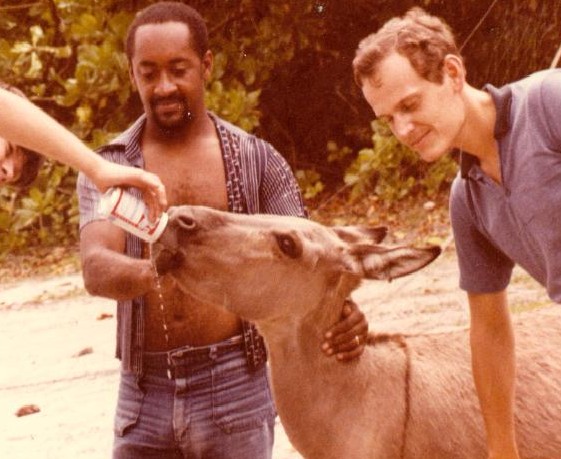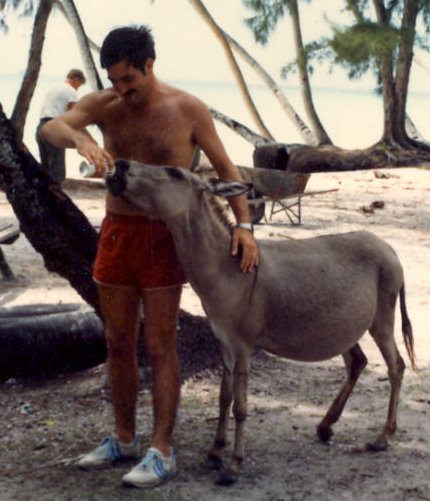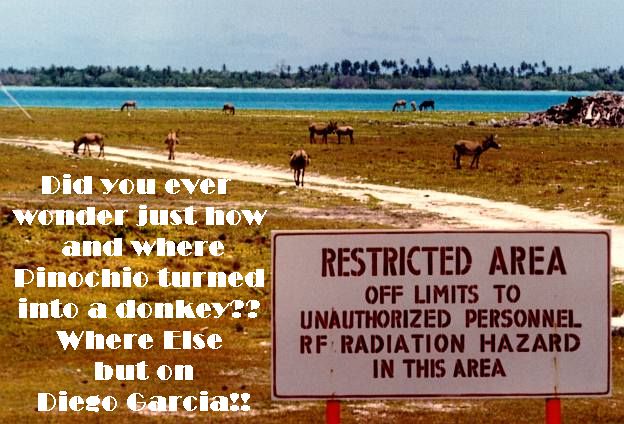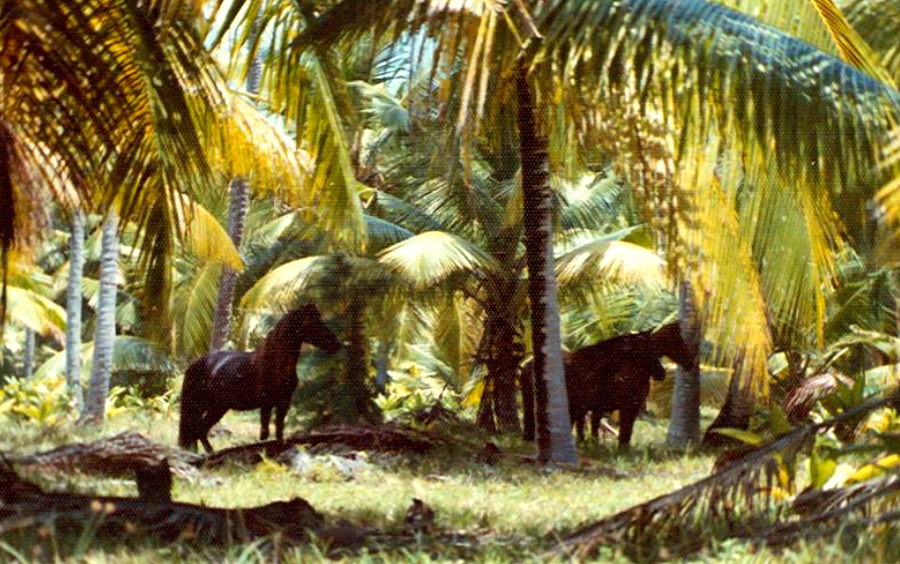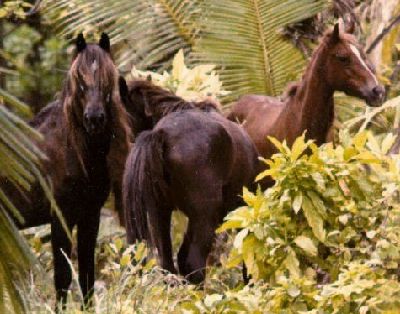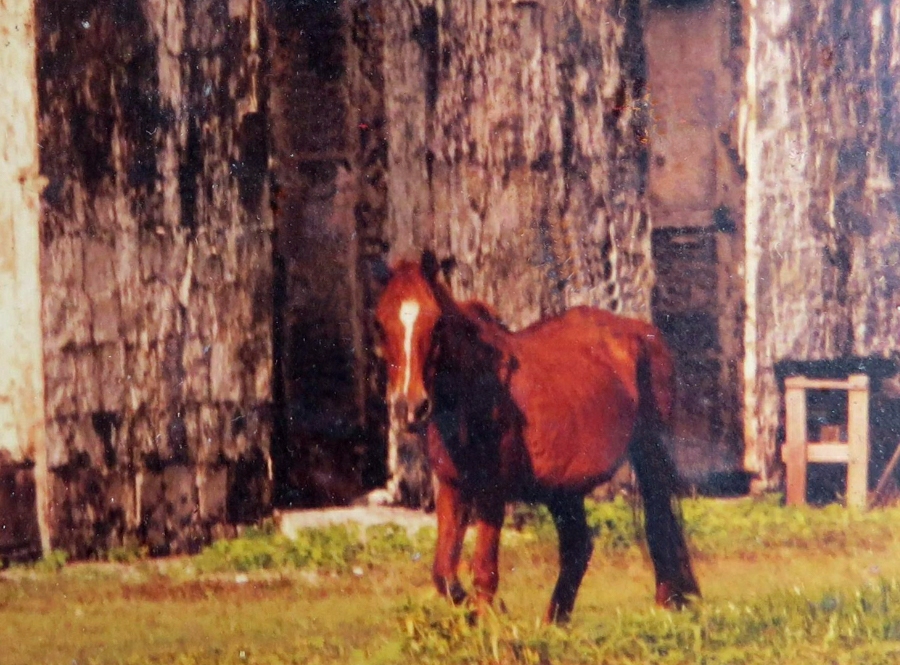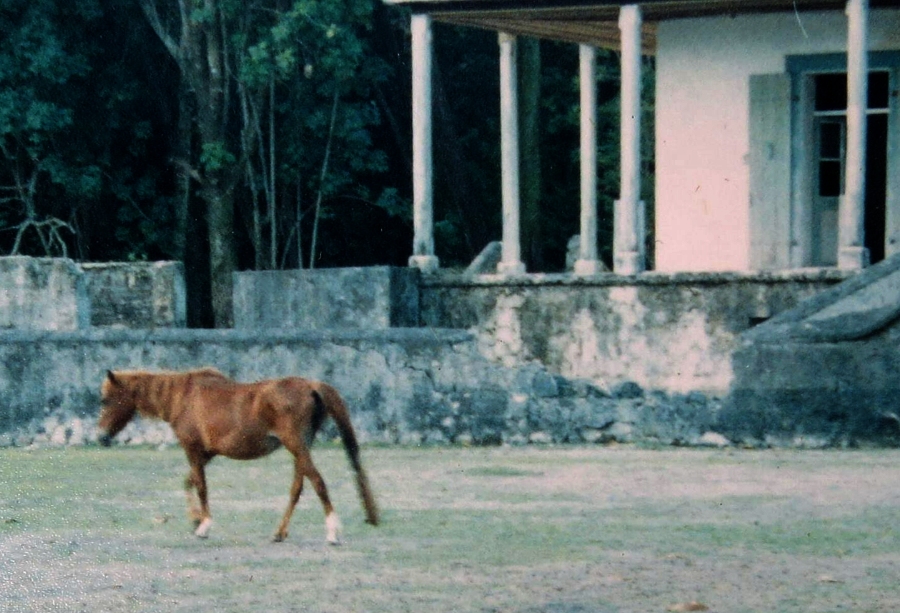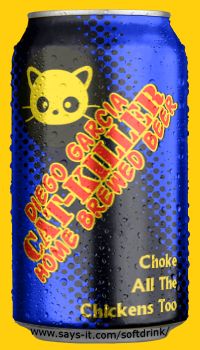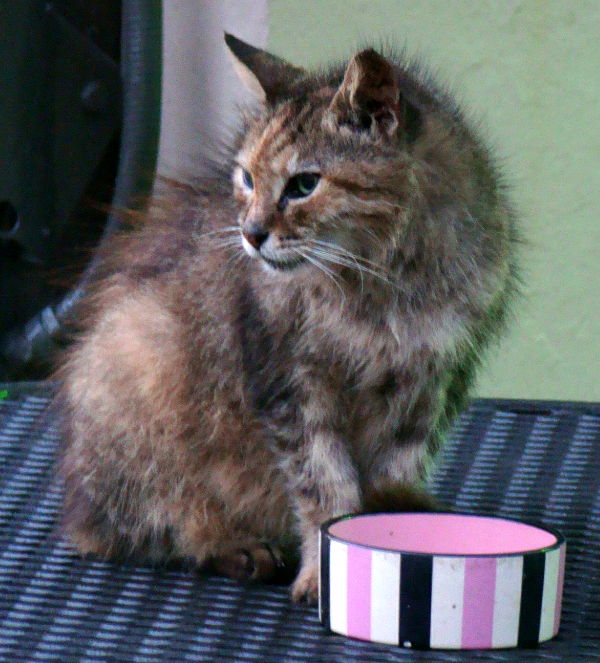
There were no amphibians found by Stoddard et al in 1967 (though there were four species of earthworm), and I saw none there in 1982 during my TDY. However by the time I returned in 1987, there were a great number of toads around Point Marianne. The airfield construction in the early 1980s had resulted in a large catchment area at the southeast end of the field, which filled with and retained fresh water. The area was basically a marsh, and there were innumerable toads and tadpoles in the area. Many toads were squished every night on the road in that area. I have no idea where they came from (especially as I don't believe in spontaneous generation), and there were no books available on the island to assist with their identification, but they surely must have come aboard the Mary Jane, our monthly supply ship from Subic Bay in the Philippines, since somehow it is difficult to imagine a toad climbing up the boarding ladder to get on a C-141 flight (though I suppose it could happen). 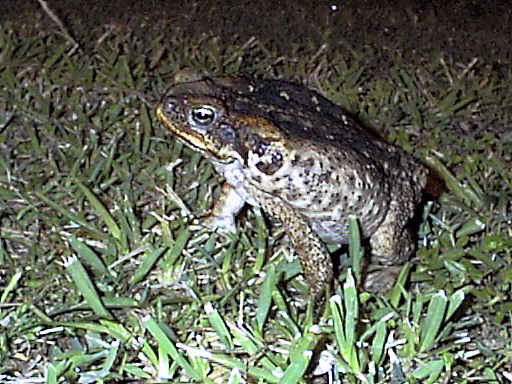 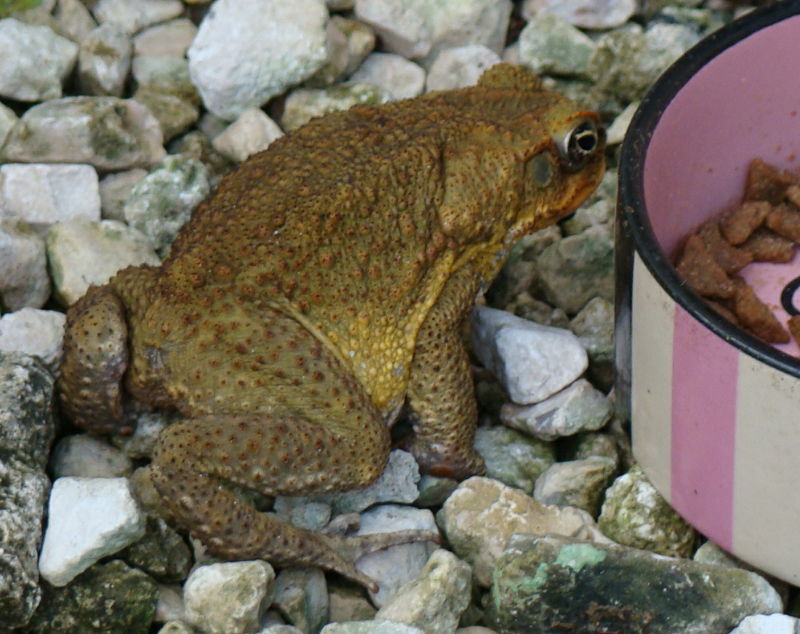
Top Photo: Many thanks to Dan Cornine for the Toad Photo (from Point Marianne area, 1999) Bottom Photo: Many thanks to Stacie J. for this one at the GPS site, 2011 - it is stealing cat food!
REPTILES There
are three lizards found on Diego Garcia
as of 2011. They are: Hemidactylus frenatus (the common house gecko) Lepidodactylus lugubrus (Mourning gecko) An Agamid lizard, Calotes versicolor (Garden lizard), and Bufo marinus (Marine toad, a.k.a. Cane Toad) Geckos have been on the island for decades, if not centuries, no doubt coming in on ships in the old days, and possibly even brought in purposefully to eat mosquitos. House Geckos aren't normally found in forest habitat - they hang out around humans and their buildings. The Mourning Gecko is also found around buildings, but can also be found in smaller numbers in the forest all over the island. In 2001, the Garden Lizard was first observed in the vicinity of "Beach House", where it slowly increased in population until it spread both south and north and can now be found downtown. None of the island reptiles have any serious competition ecologically speaking, and few, if any, predators, now that the cat population has been exterminated island-wide. Within
the last 20 years there have been a
number of snakes captured at the ports
of entry. These include: a viper
(possibly an Echis species) from the
Middle East, a Reticulated Python
(Python reticulatus), and a probable
Wolf snake (Lycodon species).
There was also a probable Brown
Treesnake sighting. Snakes could
pose a very serious problem for the
island ecosystem, and the island command
goes to great lengths to capture or kill
every possible intruder (see the story
of the hunt
for the Brown Treesnake on this
website). Presently, environmental
staff conducts bi-yearly training and
education for port workers on the
capture and identification of exotic
species.
 INSECTS
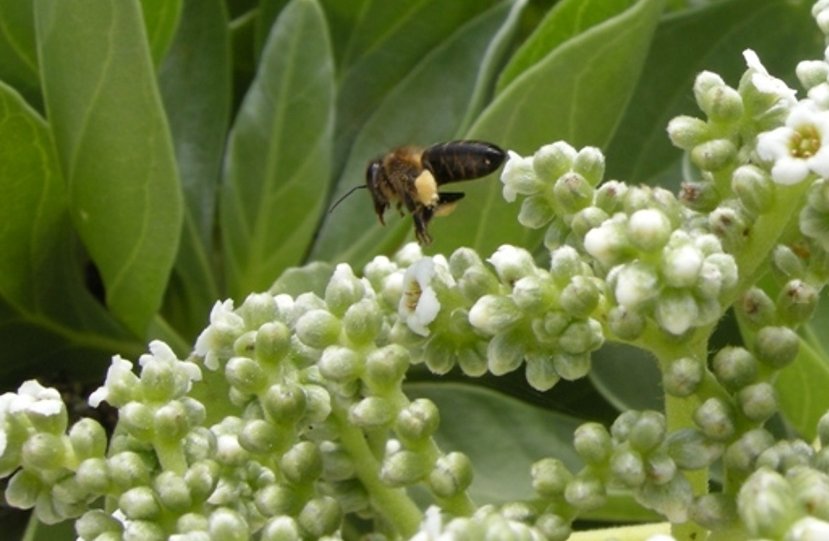 In 1988, my friends Chris and Jane, both ROPOs, were attacked by these bees, which are the agressive African version.  MAMMALS DONKEYS:
Below: The most famous
donkey on DG. SEABEEs adopted the colt you
see here in 1971.
In addition to people, rats, chickens, and cats, the British brought Sicilian Donkeys to the island for use on the plantations in about 1850. The reason was that the emancipation laws of Great Britian forbade using people to do work that could be done by animals - before the donkeys arrived the slaves had done all the hauling and dragging of the carts with the coconut nuts to the copra processing sheds at the East Point plantation. Eventually, the managers built little railroad tracks (about 2 feet apart) all over the island on which the copra carts traveled, making life easier for the donkeys. When the U.S. started construction of the airfield in 1971, and the islanders were shipped "home" to Mauritius and the Seychelles, the donkeys were turned loose, and eventually removed to south of the airfield. A fence was built across the narrowest part of the island on the west arm (which was less than 100 yards across at that point), and the donkeys left to their own devices. Even Missy, The Beer Drinking Donkey, (photo above right) who was raised from a colt by the SEABEES, was banished. By the way, never raise donkeys on booze. Missy died at the age of 12 from liver disease and chronic founder. Normally, donkeys live to be 30 years old or so. 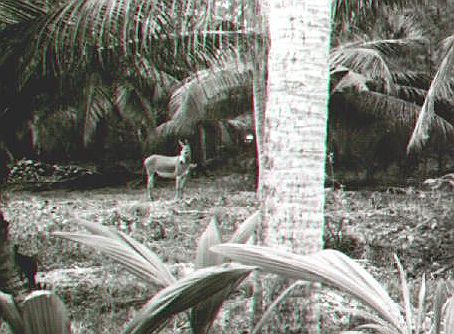 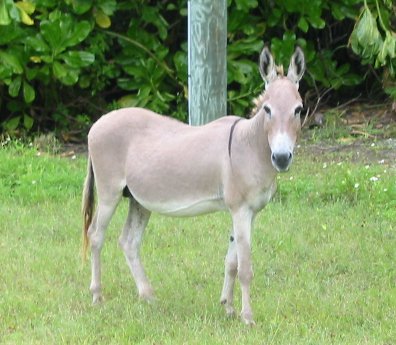 By 1990, donkeys were the dominant mega-fauna of Diego Garcia (after the deaths of the 3 horses left behind when the Plantation closed). Everybody has a photo of them in their collection. The two photos above show that the donkeys don't change much in appearance or habits over the years. The photo on the left above is from 1971, and the one on the right from 2003. They prefer open spaces and gather in large groups wherever there is grass, but could be seen in the jungle in ones and twos as well. In 1987, there were estimated to be about 400 donkeys on the island, about twice the population in 1972. As is widely reported elsewhere, the dogs left behind by the deported Ilois were killed, to prevent an infestation of feral carnivores. Initially, the donkeys were left alive as an 'emergency food source', but by 1982, a program to kill them was proposed as well. However, animal rights groups in the U.K. protested, and they were not slaughtered, unlike the cats (which were for all intents and purposes were killed off by 2008).  |
Cindy Qoth's October 2000 Update - "I
was reading the Nature pages, and you mentioned
geckos. They are all over the place
now! I really don't recall there being many,
if at all before. It is really kinda creepy
making rounds in the middle of the nite and
walking some places in BEQ 14, one or two spots
with 20 or so of them on the roof of the walkways
and walls. The make sort of a chirping
croak...very weird. At least they are
cute. The Cattle Egrets have taken the
place of all the chickens, and are all over.
There is a chicken cull every quarter, where only
the roosters are supposed to be taken. Of
course, the hens are, too, and it pissed off a lot
of people to have bitty chicks left to fend for
themselves or get eaten by...things. The
frogs/toads whatever are all over the
place...there were more until the rat poison was
put out. The rats were everywhere, so poison
was put out. Then there were less land crabs
and frogs, the flies fed off the rats,
and on up/thru the food chain. The crabs
must be getting hit worst, they eat the dead rats
AND the dead frogs." |
|
Want to use something from this site? See the TERMS OF USE. This, and everything else I write and every photo I produce is copyrighted by Ted A. Morris, Jr. |
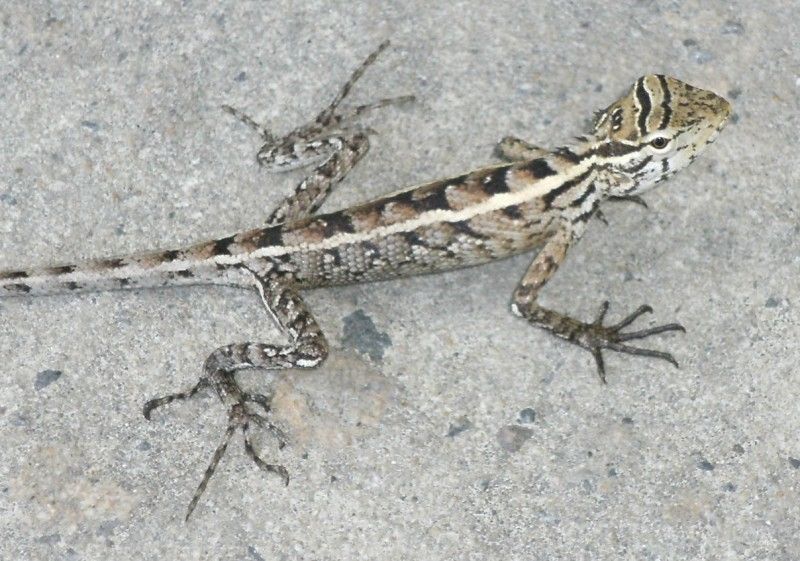
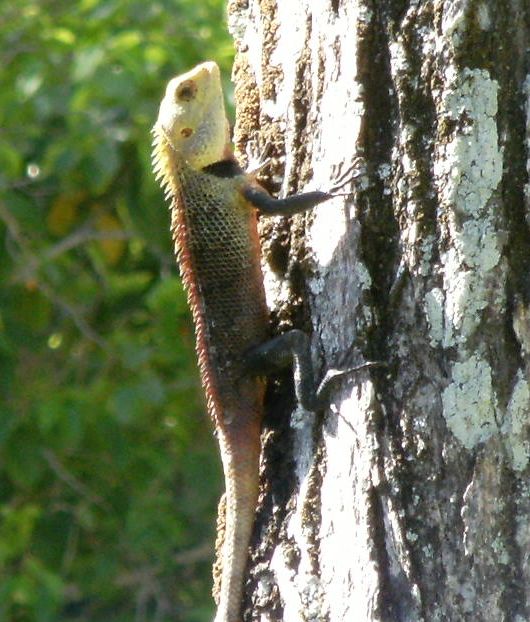
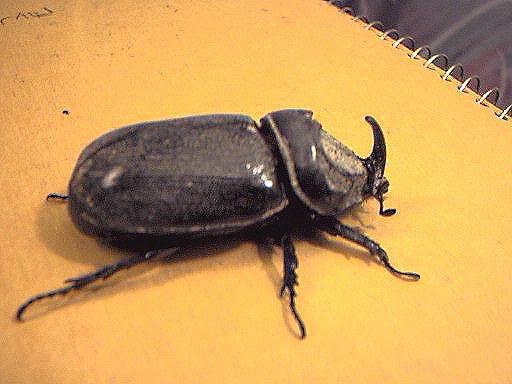
 Rhinoceros
beatles (Oryctes rhinoceros) are found all over in
the litter underneath trees. These are about
3 inches long, and only the males have the
horn. They are nocturnal and very rarely
seen. In fact, people who claim to have seen
them are usually accused of public
drunkeness. Beckie Holloway, who took this
photo of a female Rhino, says they are so
oblivious to their surroundings, they'll walk into
puddles and drown.
Rhinoceros
beatles (Oryctes rhinoceros) are found all over in
the litter underneath trees. These are about
3 inches long, and only the males have the
horn. They are nocturnal and very rarely
seen. In fact, people who claim to have seen
them are usually accused of public
drunkeness. Beckie Holloway, who took this
photo of a female Rhino, says they are so
oblivious to their surroundings, they'll walk into
puddles and drown. 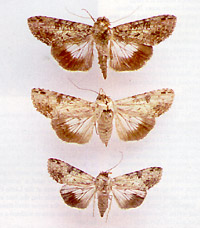 BIG NEWS:
Phil Jones passed on the following
information: A pair of British
entomologist have discovered a previously
unknown species of Moth living in the Chagos
Archepelago, and of course on Diego
Garcia! Read all about it in the British
Ministry of Defence conservation magazine
BIG NEWS:
Phil Jones passed on the following
information: A pair of British
entomologist have discovered a previously
unknown species of Moth living in the Chagos
Archepelago, and of course on Diego
Garcia! Read all about it in the British
Ministry of Defence conservation magazine 